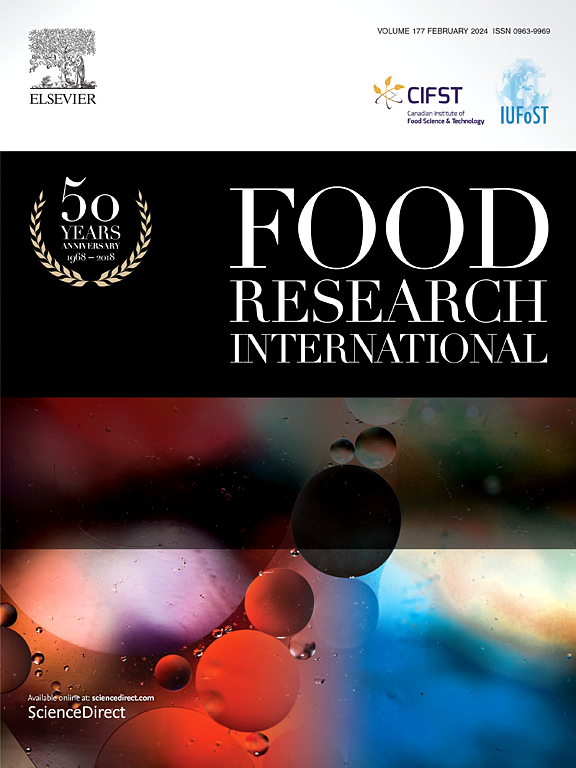Fortifying an emulsified meat product with co-encapsulated omega-3 fatty acids and lutein
IF 7
1区 农林科学
Q1 FOOD SCIENCE & TECHNOLOGY
引用次数: 0
Abstract
Lutein and omega-3 fatty acids, particularly eicosapentaenoic acid (EPA) and docosahexaenoic acid (DHA), offer significant health benefits, especially when consumed together. However, their incorporation in food is often low due to their instability during processing and storage. Meat products play an essential role in human nutrition and are generally deficient in lutein and omega-3 fatty acids. This study aimed to incorporate co-encapsulated lutein and fish oil into emulsified meat products to improve their nutritional value. Curcumin (CUR) was used as an antioxidant in fish oil-lutein encapsulation, resulting in the lowest TBARS peak value and net increase during the 7-day storage under accelerated conditions (at 40 °C). While the addition of fish oil increased TBARS values, encapsulation significantly reduced oxidation compared with the free fish oil-lutein mixture. The incorporation of encapsulated fish oil-lutein increased the omega-3/omega-6 ratio from 0.36 to 0.90 and the DHA and EPA levels by 5 and 17 folds, respectively, of the control. Encapsulation doubled the lutein content in the cooked meat and improved its retention rates, from 63.59 % and 82.23 % to 84.50 % and 97.50 %, suggesting that encapsulation prevented lutein degradation during cooking and storage. These findings suggested that co-encapsulation is an effective strategy for fortifying meat products with both lutein and omega-3 fatty acids.

强化乳化肉制品与协同封装的ω -3脂肪酸和叶黄素
叶黄素和omega-3脂肪酸,尤其是二十碳五烯酸(EPA)和二十二碳六烯酸(DHA),对健康有显著的好处,尤其是一起食用时。然而,由于它们在加工和储存过程中的不稳定性,它们在食品中的掺入率往往很低。肉制品在人体营养中起着至关重要的作用,通常缺乏叶黄素和omega-3脂肪酸。本研究旨在将叶黄素和鱼油共包合加入乳化肉制品中,以提高其营养价值。在鱼油叶黄素包封过程中,姜黄素(Curcumin, CUR)作为抗氧化剂,在加速条件下(40℃)保存7天,TBARS峰值最低,净值增加。虽然添加鱼油增加了TBARS值,但与游离鱼油-叶黄素混合物相比,包封显著减少了氧化。胶囊鱼油叶黄素的掺入使omega-3/omega-6比值从0.36提高到0.90,DHA和EPA水平分别提高了5倍和17倍。包封使熟肉中的叶黄素含量增加了一倍,并提高了叶黄素的保留率,从63.59%和82.23%提高到84.50%和97.50%,表明包封阻止了叶黄素在烹饪和储存过程中的降解。这些发现表明,共包封是一种有效的策略,以加强肉制品与叶黄素和ω -3脂肪酸。
本文章由计算机程序翻译,如有差异,请以英文原文为准。
求助全文
约1分钟内获得全文
求助全文
来源期刊

Food Research International
工程技术-食品科技
CiteScore
12.50
自引率
7.40%
发文量
1183
审稿时长
79 days
期刊介绍:
Food Research International serves as a rapid dissemination platform for significant and impactful research in food science, technology, engineering, and nutrition. The journal focuses on publishing novel, high-quality, and high-impact review papers, original research papers, and letters to the editors across various disciplines in the science and technology of food. Additionally, it follows a policy of publishing special issues on topical and emergent subjects in food research or related areas. Selected, peer-reviewed papers from scientific meetings, workshops, and conferences on the science, technology, and engineering of foods are also featured in special issues.
 求助内容:
求助内容: 应助结果提醒方式:
应助结果提醒方式:


